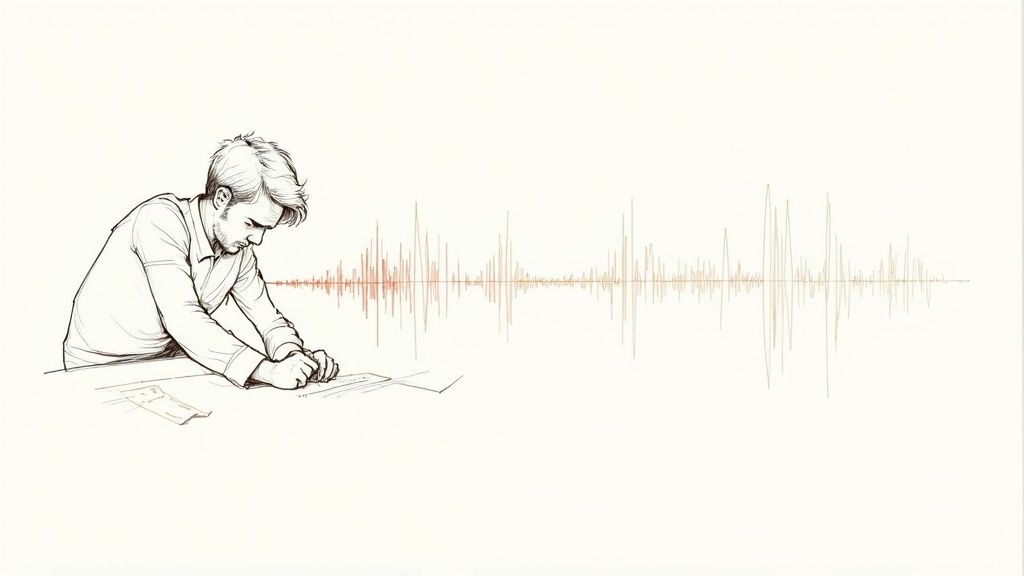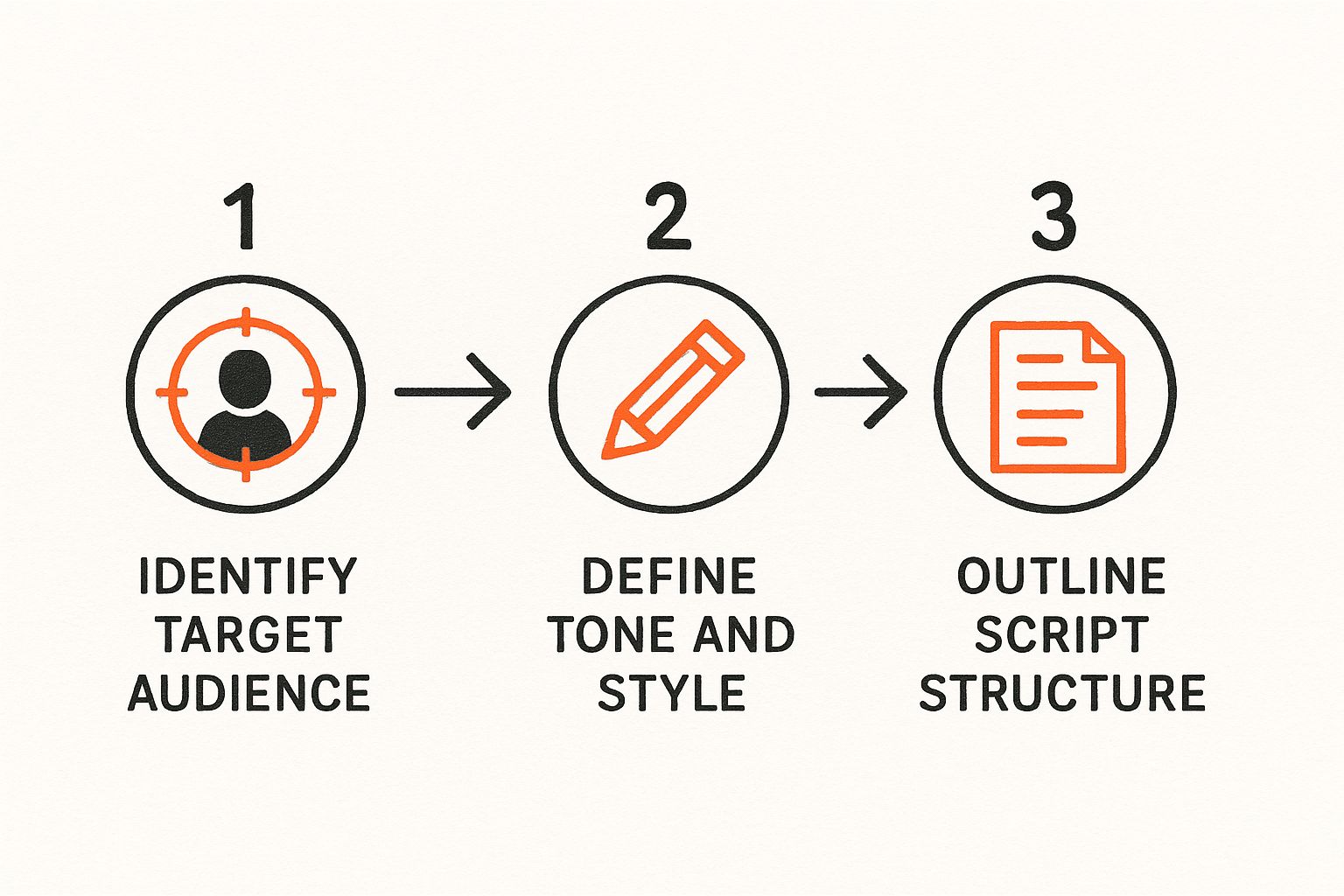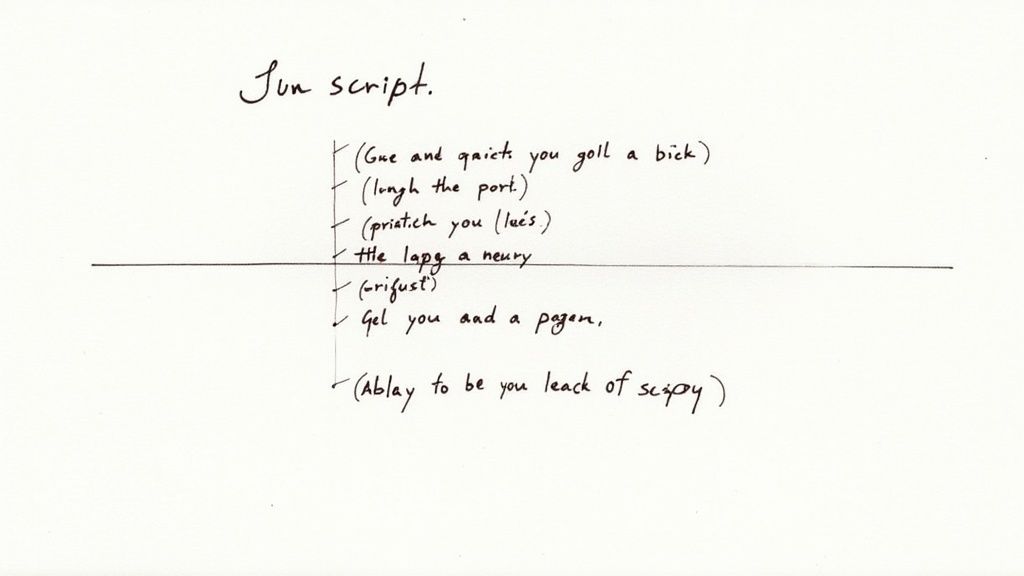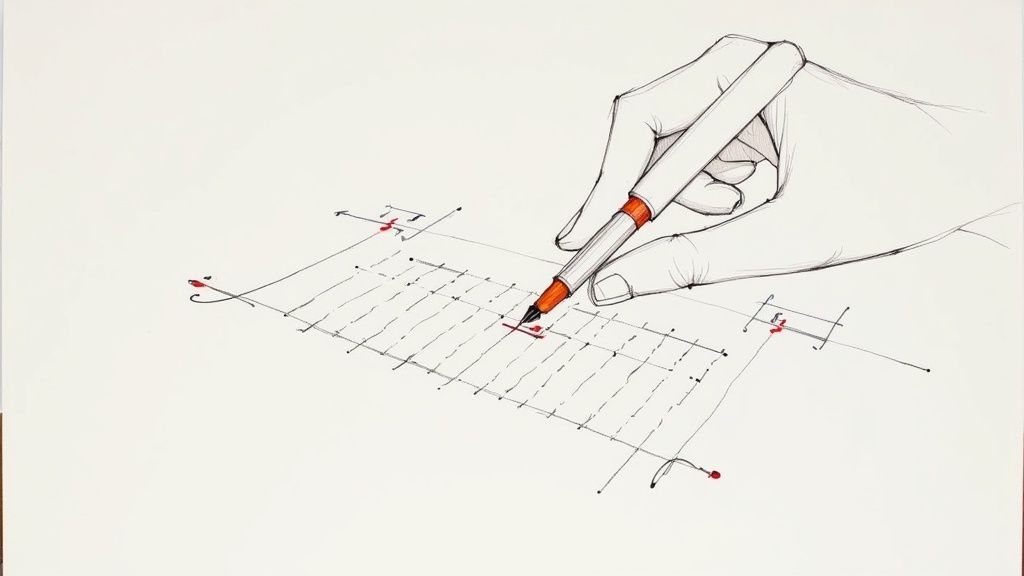Writing a Script for Voice Over That Connects

A truly great script for voice over isn't just about the words you choose. It's built on a solid foundation, and that starts long before you ever type a single sentence. The real magic happens when you get crystal-clear on your message and who you're talking to.
Defining Your Core Message and Audience

Jumping straight into writing without this clarity is like starting a road trip without a map—you’ll end up somewhere, but it's probably not where you intended to go. Before a script can connect, it needs two things: a specific message and a deep understanding of your listener.
This planning phase is absolutely non-negotiable. Kick things off by asking one simple but powerful question: "What's the one thing I want my audience to remember when this is over?"
That answer? That’s your core message. Everything else in the script should exist only to support and reinforce that single idea. To make sure you’re always on point, it helps to have a robust effective brand messaging strategy in place before you start writing. This ensures every word aligns with your core identity.
Know Who You're Talking To
Once your message is locked in, it's time to shift focus to your audience. Don't just think about them in broad terms; create a detailed listener persona. This isn't just about demographics. You need to dig into their motivations, their pain points, and what they already know about your topic.
Ask yourself these questions:
- What problem are they actually trying to solve?
- What kind of language do they use every day? Slang? Jargon? Formal?
- What feeling do you want to leave them with? Inspired? Reassured? Excited?
Answering these helps you find the right words and adopt a tone that feels natural and familiar to them. A script aimed at a group of seasoned software developers will sound completely different from one written for first-time gardeners.
The goal is to make your listener feel like you're speaking directly to them, creating a one-on-one conversation rather than a broadcast to a faceless crowd.
Choosing the Right Tone of Voice
Your tone is the emotional color of your script. It’s what gives your words feeling and personality. The right tone can build trust, generate excitement, or offer comfort, depending on your goal.
Think about what you're trying to achieve with your voice-over:
- Informative and Authoritative: This is perfect for educational content or corporate training videos. The tone should be clear, direct, and confident.
- Friendly and Conversational: Ideal for explainer videos, commercials, or brand stories. It feels approachable and builds a sense of trust.
- Energetic and Enthusiastic: Use this for promotional content or product launches. It’s all about creating a buzz and a sense of urgency.
When you nail down these foundational pieces—your message, your audience, and your tone—every single sentence in your script for voice over will have a clear purpose. This isn't just about writing; it's about strategic communication that gets the job done, whether that's to inform, persuade, or entertain.
How to Structure Your Script for Maximum Impact
Once you've nailed down your core message and who you're talking to, structuring the script itself becomes a whole lot easier. A good structure is like a roadmap for your listener. It guides them from the first moment of curiosity right through to the end goal, making sure your message actually lands.
Think of it like building a bridge: you need a strong foundation, a clear path across, and a definite destination.
This visual guide breaks down the essential planning steps you should take before a single word of the script is written.

As you can see, a solid script outline starts with knowing your audience inside and out and deciding on the exact tone that will connect with them.
The Anatomy of a Powerful Script
Every great voice-over script I've ever seen, no matter the project, has three key parts. The trick is learning how to adapt this simple framework for whatever you're creating, whether it's a quick social media ad or a detailed training video.
- The Hook: You’ve got maybe three to five seconds to grab someone's attention. Seriously, that's it. Kick things off with a surprising fact, a relatable question, or a bold statement that makes them lean in and listen.
- The Body: This is the meat of your script where you deliver the goods. Lay out your information in a logical flow, using simple transitions to connect your ideas. If you're creating educational content, a basic understanding of instructional design principles can be a huge help here for organizing everything effectively.
- The Call-to-Action (CTA): Always end with a clear, direct instruction. Tell your listeners exactly what you want them to do next. Is it visiting a website? Subscribing? Making a purchase? Don't leave them guessing.
This simple Hook-Body-CTA structure is a reliable skeleton you can build almost any script on.
Formatting for Flawless Delivery
How you format the script is just as important as the words you choose. This is especially true if you're working with a human voice actor or an AI voice generator—the goal is to make the script dead simple to read and perform.
To help you get this right, here’s a quick-reference table covering the essentials.
Voice Over Script Format Essentials
| Formatting Element | Purpose | Example |
|---|---|---|
| Short Paragraphs | Creates natural pauses and makes the script easier to digest for both the performer and the listener. | Keep each paragraph to just one or two sentences. It’s much easier to read aloud. |
| Simple Language | Ensures the message is clear and sounds conversational, not robotic or academic. | Instead of "utilize," say "use." Instead of "facilitate," say "help." |
| Director's Notes | Provides crucial context for tone, emotion, or specific actions, guiding the performance. | [Tone: warm and reassuring] [Pause for 2 seconds] |
| Phonetic Spelling | Prevents mispronunciation of difficult words, names, or technical jargon. | "Our new GigaHertz processor..." [say: GEE-ga-hertz] |
| Spelling out Numbers | Avoids ambiguity and ensures numbers are read naturally. | Instead of "1,200," write "twelve-hundred." Instead of "10/3," write "October third." |
Getting these formatting details right from the start will save you a world of headaches during production.
Keep your paragraphs super short—one to three sentences, max. This forces natural pauses into the delivery and stops the voice-over from sounding rushed or like a monotonous wall of text.
Your script is a performance guide, not a novel. Write for the ear by using simple, conversational language. If a phrase feels awkward to say, it will sound even more awkward when recorded.
And please, don't be shy about adding director’s notes! Use brackets to specify a tone [friendly and upbeat] or to clarify how to say something tricky [say: GEE-ga-hertz]. This is absolutely crucial for getting the perfect take, especially with jargon or unique brand names. Mastering these little formatting details is a key part of good voice over recording practice.
When you focus on a strong structure and clean formatting, you turn a simple text document into a powerful communication tool. This prep work is what ensures a smooth, professional-sounding final product that connects with your audience and hits your goals.
The Art of Writing for the Human Ear

Here’s something you learn quickly in this business: writing for someone to listen is a whole different ballgame than writing for someone to read.
When you write for the page, people can scan, go back, and digest things at their own pace. But spoken words are gone in an instant. They have to land and make sense the very moment they’re heard.
This single difference changes everything. Your script for voice over has to be all about clarity, simplicity, and natural rhythm. I’ve seen countless sentences that look perfectly fine on paper turn into a clunky, confusing mess when spoken out loud. Your job is to make sure that never happens.
Embrace Simple Language
One of the biggest traps writers fall into is trying to sound too formal or academic. They cram sentences with jargon and complex words, thinking it adds authority. For voice overs? It does the exact opposite.
Simple, clear language always wins. It's more accessible, easier to follow, and just feels more real. You're trying to build a connection, and that's impossible if your audience is busy trying to figure out what you just said.
Let me give you a quick before-and-after:
- Written for the eye: "The subsequent implementation of our proprietary logistical framework will facilitate a significant enhancement in operational efficiency across all verticals."
- Written for the ear: "Next, our new system will help make work run much more smoothly for every team."
See the difference? The second version is direct, conversational, and you get it instantly. It’s how a real person would actually explain it.
Write in an Active, Conversational Voice
To really pull the listener in, write like you're talking to a single person. Use an active voice to keep your sentences direct and full of energy. It makes it crystal clear who's doing what, which is far easier for the brain to process on the fly.
For example, instead of the passive, "The report was reviewed by the team," flip it. "The team reviewed the report." It’s a tiny change that makes a huge difference in punch and clarity. If you want to dive deeper into performance, exploring some essential voice acting techniques for beginners can give you great insight into how to deliver lines with real authenticity.
Here's a pro tip I swear by: read every single line of your script out loud while you're writing it. If you stumble over a sentence or it just feels weird to say, rewrite it. Keep tweaking until it rolls right off the tongue.
Use Punctuation as Your Director
In a voice-over script, punctuation is more than just grammar—it's your direction to the voice actor. Think of commas, periods, and ellipses as a secret code for pacing and emphasis.
- Commas (,) are your friend for creating small, natural pauses for breath or thought.
- Periods (.) signal a full stop, giving an idea a sense of finality.
- Ellipses (...) can suggest a longer, more dramatic pause or a thought that's trailing off.
By using punctuation deliberately, you can guide the rhythm and make sure the key points land exactly how you want them to. It's what separates a flat, robotic reading from a truly dynamic performance.
This is also where thinking globally comes into play. While English is often the default, demand for other languages is booming. Recent industry stats show that while 49% of businesses prioritized English voice-overs, Spanish and Chinese were right behind them at 46% and 28%. Writing with clear language and intentional pacing makes your script infinitely easier to translate and adapt for these audiences.
Alright, let's get that first draft polished up. Think of it less as an editing phase and more as where the real magic happens. Your first pass is just getting the clay on the wheel; now it's time to shape it into something special. This is where you trim the fat, smooth out any clunky phrasing, and make sure every single word pulls its weight.
The most powerful tool for this part of the process is completely free and only takes a few minutes: read your script out loud.
Seriously. It’s a game-changer.
Words that look great on the page can sound incredibly awkward when spoken. Reading your script aloud is the fastest way to find where the rhythm is off, where your sentences drag on forever, or where the language just doesn't feel like something a real person would say.
The Self-Editing Gauntlet
As you read, you need to be your own toughest critic. Don't just drone through the words—perform them. Feel how they roll off the tongue. This is how you catch the problems that your eyes will skim right over.
Here’s a quick checklist to run through as you revise:
- Is it crystal clear? Can someone listening for the first time instantly grasp your main point in every sentence?
- Is it tight? Hunt down and destroy filler words. Can you say the same thing with fewer words? Phrases like "in order to" or "that being said" are usually the first to go.
- How's the pacing? A great script has a natural ebb and flow. You need to build in pauses for the listener to breathe and let your ideas sink in.
- Is the tone consistent? If you started with a high-energy, upbeat intro, it's jarring to suddenly shift into a dry, monotone explanation. Make sure the vibe is consistent from start to finish.
The point of editing isn’t just catching typos. It’s about making the script effortless for the listener. If you stumble while reading it aloud, your audience will definitely stumble while hearing it.
Crunching the Numbers and Getting a Second Opinion
A huge part of refining your script is making sure it actually fits the time you have. In the voice-over world, the general rule of thumb is that a professional English-speaking voice actor will deliver about 150 words per minute (WPM).
This means a 60-second video needs a script right around the 150-word mark. A snappy 30-second ad? You're aiming for about 75 words. Time yourself reading the script at a natural pace and see how your word count stacks up.
Finally, after you've tweaked and polished it to death, pass it to someone else. You’re too close to it now. A fresh set of ears will immediately pick up on confusing sentences or awkward phrases you’ve become completely blind to. Ask them to read it out loud and point out any spot where they get tripped up. That feedback is pure gold for making sure your script truly connects.
Bringing Your Script to Life with AI
Once your script is polished and ready, it’s time to give it a voice. This used to be the hard part—the expensive, time-consuming bit involving studios and actors. Not anymore. Today, you can generate a professional-grade narration in just a few minutes, right from your desk.
The world of voice-over has changed dramatically, and fast. The rise of AI has been a huge part of that. As recently as 2020, AI voices were pretty robotic. Fast forward to today, and they can now capture human-like emotion and nuance, making them a solid choice for everything from audiobooks to marketing videos. While several great tools exist, including Murf.ai and WellSaid Labs, we built Lazybird specifically for creators who need an easy-to-use platform that delivers premium, natural-sounding audio without a steep learning curve.
Turning Text into Voice Instantly
This is where a tool like Lazybird comes in. It's the bridge between your written words and a finished audio file, putting you in the driver's seat without any technical headaches. The whole process is designed to be as simple as possible.
When you start a new project, this is what you’ll see. Clean, simple, and ready to go.

Just paste your script, pick a voice, and hit generate. That's it. It removes the usual barriers and lets you focus completely on your creative vision.
For your script for voice over, using an AI voice generator like Lazybird has some clear wins:
- Speed: Forget waiting days. You can go from a final script to a finished audio file in minutes.
- Cost: You get to skip the high costs of renting a studio or hiring professional voice talent.
- Flexibility: Realize you need to tweak a sentence? No problem. Just edit the text and regenerate the audio on the spot. No reshoots, no re-bookings.
Fine-Tuning Your AI Voice Over
After pasting your script into Lazybird, the fun really begins. You’re not just getting a generic, one-size-fits-all reading. You get to direct the performance, just like you would with a human actor.
You can browse a huge library of voices to find the perfect match for your brand's personality. Need something authoritative? Friendly? High-energy? You’ll find it.
With Lazybird, you are the director. You have granular control over the delivery, allowing you to adjust the tone, pitch, and pacing to ensure the emotional weight of your script is conveyed perfectly.
This level of control is what turns an AI voice-over from a simple utility into a powerful creative tool. It's not just about automation; it's also fascinating to see how AI can help us be more creative by opening up new ways to experiment.
If you're just getting started, we put together a guide that walks you through https://www.lazybird.app/blog/how-to-use-ai-voice to get the best results. By pairing a great script with the right AI voice and a few small adjustments, you can create a final voice-over that sounds natural, professional, and totally engaging.
Common Questions About Writing Voice Over Scripts
Even with the best-laid plans, a few questions always pop up when you're in the thick of writing. It happens to everyone. Let's tackle some of the most common hurdles I see writers face when putting together a script for voice over.
How Long Should My Script Be?
This one's easy: the length is completely dictated by where it's going to live.
- For a punchy 30-second social media ad, you're looking at about 75 words.
- If you're putting together a one-minute explainer video, the industry standard is right around 150 words.
The most reliable way to gut-check your timing is just to read the script out loud. Seriously. Read it at a natural, conversational pace. A great rule of thumb is that the average English-speaking narrator reads at about 150 words per minute (WPM).
Whatever you do, don't try to cram too much in. A clear, impactful message will always beat a script that’s overloaded with information.
How Is Writing for Video Different from Audio Only?
When you’re writing for video, your words are part of a team. They have to play nice with the visuals on screen. This actually lets you be more concise because the images, graphics, and text are doing some of the heavy lifting. Your main job is to make sure the narration syncs up perfectly with what the audience is seeing.
For an audio-only format, like a podcast intro or an audiobook, your words are the entire show. The script has to work a lot harder. It needs to be descriptive and vivid enough to paint a complete picture in the listener's head and hold their attention without any help from visuals. This is where a much richer use of language comes into play.
How Do I Add Emotion to a Script for an AI Voice?
This is where modern AI tools have really changed the game. With a platform like Lazybird, you have a surprising amount of control over the emotional delivery.
It all starts with your word choice, of course. Use emotive language that naturally hints at a specific tone. From there, you can use punctuation to guide the performance. An ellipsis (...) can create a thoughtful pause, while an exclamation point can inject a bit of excitement.
The real magic happens inside the AI voice generator itself. You can fine-tune the delivery by adjusting settings like pace, pitch, and volume for specific words or whole sentences. I always recommend experimenting with different AI voices, too—each has its own unique style, and you can often find the perfect emotional match for your script just by trying a few out.
With those questions answered, you should be ready to lock in your script and bring it to life.
When you're ready to turn that text into a polished, professional recording, give Lazybird a try. Our platform makes it incredibly simple to generate high-quality, human-like voice overs in just a few minutes. Just paste your script, pick the perfect voice from our extensive library, and direct the performance until it's perfect—all within one easy-to-use app.
Start creating for free at https://lazybird.app.